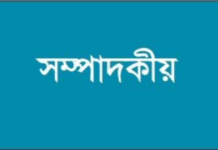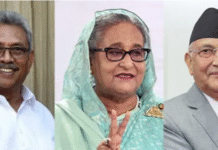
Nearly half a century after the 1971 War of Liberation, it is perhaps difficult to produce or come across startlingly original ideas about Tajuddin Ahmad. But it is always instructive to study the existing literature on his political career, primarily because of the lessons it provides, but also because it helps us see the history of our independence struggle in a broader context in terms of its relation to other forces and influences that were at play. Tajuddin’s active life was a relatively short one, marked by momentous changes both in this region and around the world. To understand Tajuddin is to understand the interplay of these changes in which he was both a keen observer and an active participant.
As history shows us, Tajuddin’s career took off at a time when the world was in constant flux. He saw the painful birth of India and Pakistan through an ill-conceived Partition orchestrated by the British. Globally, the imperialists were on the run. Between 1945 and 1960, about three dozen new states in Asia and Africa achieved autonomy or outright independence from their colonial rulers. The creation of so many new countries within this short period coincided with the new Cold War between the Soviet Union and the United States, which would both influence and be influenced by these developments, altering the composition of the global geopolitical scene and deepening the political complexity of nearly every region in the world. Bangladesh’s independence in 1971, of which Tajuddin was one of the chief architects, cannot be seen in isolation from these developments.
Tajuddin’s role, until that point, was that of a grassroots organiser and strategist. As general secretary of Awami League and a close confidante of Bangabandhu Sheikh Mujibur Rahman, he would get Bangabandhu’s approval for all policy decisions and strategies while Bangabandhu would engage with the public to get them behind those decisions. They were a perfect team—one carrying the torch of independence and the other, averse to publicity, providing him with backstage support. However, after the brutal crackdown of Pakistan on innocent Bengali civilians on March 25, followed by Bangabandhu’s arrest, Tajuddin found himself suddenly alone. He soon realised that it was now up to him to carry that torch forward and lead the strenuous task of organising the lines of defence from the ground up, legitimising the rightful demand of his people for self-determination through forming a government by their elected representatives, and mobilising international support for their cause.
We get a good glimpse of his activities in the next nine months from the authoritative book of Muyeedul Hasan titled “Muldhara: 71”. The book details the many challenges he faced after the April 17 oath-taking ceremony of the provisional “Mujibnagar” government (so called because of the name of the place where the ceremony was held). The government-in-exile in Kolkata, the legal basis of which was provided by the Proclamation of Independence issued on April 10—just 15 days into the Pakistani clampdown—was divided into 15 ministries and divisions. Its quick formation, besides the obvious reasons for which it was set up, also helped Awami League avert a leadership crisis in the absence of Bangabandhu. Many Bengali diplomats and members of the Civil Service of Pakistan also defected to the newly established government headed by Tajuddin Ahmad, its prime minister.
Tajuddin and his cabinet colleagues quickly set the administration on the path of achieving a number of short and long-term goals. Foremost among them: training and securing arms for the freedom fighters, building a regular army, advancing the resistance fight through both conventional and irregular warfare, rehabilitating the refugees in India, securing recognition from the international community, building an effective line of communication, freeing Bangabandhu from the Pakistani prison, etc.
For India, which gave shelter to millions of refugees from Bangladesh fleeing the war and provided training and military support in different phases, there were ostensibly three reasons for supporting the cause of liberation, according to Muyeedul. First, its continued hostile relations with Pakistan and prior support for the Bengali demand for autonomy. Second, the ideological proximity between Awami League and the ruling Congress Party, especially on issues of parliamentary democracy and non-communalism. The third reason was a humanitarian one, ignited by the Pakistani brutalities targeting innocent civilians. But there were also risks to consider: any direct military intervention from India could be used by Pakistan to turn its “civil war” into an Indo-Pak war which could pave the way for military intervention from the US and China. The US, ignoring world opinion and the plight of the persecuted Bengalis, was already playing a very active role in Pakistan’s favour. In terms of powerful allies, India still had none. So without securing support from the Soviet Union to tip the scales in its favour, it couldn’t risk getting involved militarily even if it meant prolonging the refugee crisis.
The much-needed commitment of support came on September 28-29, when Indian Prime Minister Indira Gandhi met with top Soviet leaders in Moscow and both sides released a joint statement expressing their solidarity for the Bengali cause (Moscow had earlier described the US’ interference as a move towards “Vietnamisation of East Bengal conflict”). This meeting is regarded as a major turning point in the history of the war as it meant that India could, with the Soviet Union at its side, now act more boldly. Meanwhile, China proved to be an unreliable ally for Pakistan although it had been supplying arms to it since the beginning. The US plan to get China to keep India on a short leash by creating tensions at their shared borders never really materialised.
Tajuddin followed these developments closely and aided, when necessary, the Indian bid to counterbalance the US threat. His realistic appraisal of the situation was vital to the government’s international engagement efforts as well as adopting supportive policies. Despite the many challenges on multiple fronts, limited resources and the constraints of having to work on the soil of another country, the Mujibnagar government was successful in putting together a civil administration which worked with remarkable efficiency given the situation. Tajuddin also had to act decisively to keep the administration nonpartisan. Besides organising the whole military and political response to the emerging situations, he and those involved with the government also successfully ensured effective coordination of various activities and kept the momentum alive both for the trainees and freedom fighters back home. By December, the Pakistani confidence was largely shattered and their military position considerably weakened. Finally, when the Indian army officially entered the war on December 3, victory for the joint forces was only a matter of time.
The independence came through the efforts and sacrifices of countless people both at home and outside. Tajuddin’s extraordinary leadership along with the fearless efforts of his administration and comrades was the glue that held them all together and channelled their efforts to secure independence finally.
There are many things to learn from Tajuddin’s short yet illustrious career: his organisational acumen, political and diplomatic wisdom, and his quiet work as a nation builder, which suggest a blend of vision and pragmatism inherent to great leaders. But his most glorious moment is indeed his role during the war. In short, the art of being Tajuddin Ahmad in 1971 is the art of navigating a complex landscape of conflicting geopolitical priorities and meeting extraordinary challenges with equally extraordinary courage and foresight, while never losing hope in the potential of his people.
Badiuzzaman Bay is a member of the editorial team at The Daily Star. Email: badiuzzaman.bd@gmail.com









